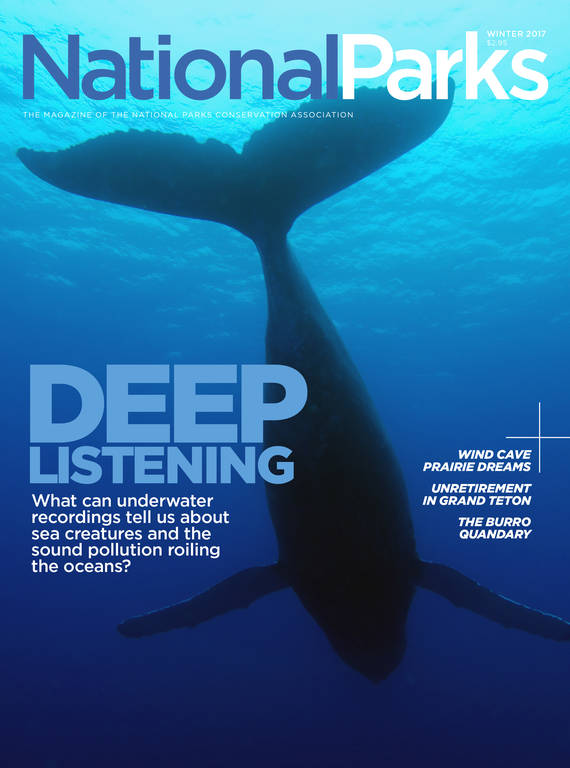Winter 2017
Killer Commodes
Backcountry toilets and birds can be a deadly combination. That’s where the Poo-Poo Project comes in.
Joe Foust knew he was in the right place from the note taped to the door: “Do not use toilet — owl inside.” He had seen some crazy things in his time as Cascade Ranger District wildlife biologist for the Boise National Forest, but a call about an owl in a campground toilet was a new one. Sure enough, once Foust opened the door and peered into the hole beneath the toilet seat, he saw the fiery eyes of a tiny boreal owl peering right back.
The bird was calm, so Foust was optimistic he could secure a quick — and clean — rescue. He took a net out of his truck, held his nose and opened the cleaning door at the back of the toilet. The bird remained still until the net got close, when it panicked and began flapping and jumping around in the chamber. “It was very very messy,” said Foust. He finally netted the bird, washed it off as well as he could with water from his truck, released it back into the woods and returned to his office with a story to tell.
That story, and the accompanying photograph, made their way through a network of biologists in the West and eventually ended up in front of Roger Smith, co-founder of Teton Raptor Center, a nonprofit raptor education, research and rehabilitation facility in Wyoming. Smith had heard reports of owls being stuck in remote toilets before, and after seeing Foust’s photo, he decided to do something about it. The Poo-Poo Project was born.
If you’ve ever visited public lands out West, you’ve probably used a vault toilet. Kind of gussied-up outhouses, vault toilets are permanent structures in areas without running water that store waste in a below-ground tank, or vault. The toilets are kept relatively fresh and odor-free thanks to vent pipes, which allow air to flow from the vault out through the ceiling.
The trouble is that to some birds, that vent pipe looks like a tree cavity, and tree cavities are places to nest, roost or cache food. They fly into the pipe and get trapped in the vault below, potentially meeting an unsavory end. Since the incident with the boreal owl at the Boise National Forest, staff at Teton Raptor Center have seen photos of other trapped owl species — small ones such as saw-whet and screech but also large owls like great horned, long-eared and barn. Other cavity-nesting birds have been found in vault toilets, including American kestrels, wood ducks and a variety of woodpeckers.
“No one knows for sure how many birds end up in vault toilets,” said David Watson, the Poo-Poo Project coordinator (the name comes from port-o-potty owl project). “It’s not the kind of thing many grad students want to spend their time researching.” But with thousands of vault toilets in remote areas across the country, significant numbers of individual birds are at risk, he said.
The concerned team at Teton Raptor Center came up with a solution: a screen that could fit over the vent pipe to keep birds out. In 2010, the center partnered with the National Park Service and U.S. Forest Service to test 100 screens on vault toilets in Grand Teton National Park and Bridger-Teton and Caribou-Targhee National Forests. These early prototypes in Wyoming and Idaho worked, but they weren’t perfect; they sat snugly on the top of the pipes and could easily become clogged by snow or leaves, interfering with ventilation.
In 2013, Teton Raptor Center introduced a new model, designed in-house and manufactured locally. The latest iteration has a more durable coating to prevent rust, and its raised lip allows air through the sides so that a toilet can be properly ventilated even when the screen’s top is covered. It was effective, and word began to spread among land managers of this inexpensive and easy way to prevent bird deaths. In the years since, Teton Raptor Center has distributed 7,677 vent screens to more than 200 partners in 27 states. The screens cost $29.95; the proceeds support the center’s work rehabilitating injured raptors and providing educational programs featuring live raptors for area students.

National Parks
You can read this and other stories about history, nature, culture, art, conservation, travel, science and more in National Parks magazine. Your tax-deductible membership donation of $25 or more entitles…
See more ›National parks were early adopters. Keri Nelson oversaw installation of the screens in the Needles District of Utah’s Canyonlands National Park, where she had previously rescued a Western screech-owl from a vault toilet. Staff at Congaree National Park in South Carolina, the first partner east of the Mississippi, bought screens for two new vault toilets. In all, 15 national parks now have Poo-Poo Project screens in place, along with dozens of U.S. Forest Service districts, Bureau of Land Management field offices, U.S. Fish and Wildlife refuges and state and local partners.
Of course, Joe Foust was an eager customer. He ordered 40 screens for his own forest district, and by mid-fall, fellow wildlife biologists had nearly finished installing an additional 150 needed to cover the entire Boise National Forest. Sure, he would save an owl in a fix again if he had to, but he has high hopes that his days of reaching into vault toilets are over. “The screens are pretty bomb-proof, especially for the bigger animals. I don’t see it happening again,” he said. “But animals can do anything. Never say never.”
About the author
-
 Nicholas Lund Former Senior Manager, Landscape Conservation Program
Nicholas Lund Former Senior Manager, Landscape Conservation ProgramNick is a nature writer whose writing on birds and nature has appeared in Audubon magazine, Slate.com, The Washington Post and more. His most recent book is "Dinosaurs to Chickens: How Evolution Works." He lives in Maine with his wife and son and works for Maine Audubon.


